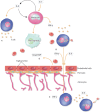In the Eye of the Storm: Immune-mediated Toxicities Associated With CAR-T Cell Therapy
- PMID: 31723828
- PMCID: PMC6746039
- DOI: 10.1097/HS9.0000000000000191
In the Eye of the Storm: Immune-mediated Toxicities Associated With CAR-T Cell Therapy
Abstract
The success of chimeric antigen receptor (CAR)-T cell therapy with impressive response rates in hematologic malignancies but also promising data in solid tumors came along with the cognition of unexpected, potentially life-threatening immune-mediated toxicities, namely the cytokine release syndrome (CRS) and neurotoxicity recently referred to as "immune effector cell-associated neurotoxicity syndrome" (ICANS). These toxicities require urgent diagnostic and therapeutic interventions and targeted modulation of key cytokine pathways represents the mainstay of CRS treatment. However, as the underlying mechanisms of ICANS are not well understood, treatment options remain limited and further investigation is warranted. Importantly, after the recent market approval of 2 CAR-T cell constructs, the application of CAR-T cells will expand to nonacademic centers with limited experience in the management of CAR-T cell-associated toxicities. Here, we review the current evidence of CRS and ICANS pathophysiology, diagnostics, and treatment.
Copyright © 2019 the Author(s). Published by Wolters Kluwer Health, Inc. on behalf of the European Hematology Association.
Figures




References
Publication types
LinkOut - more resources
Full Text Sources
Other Literature Sources
